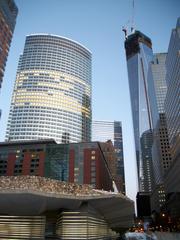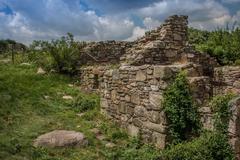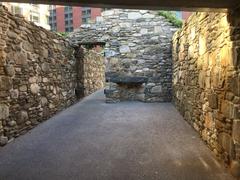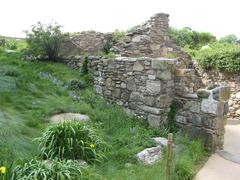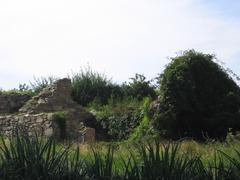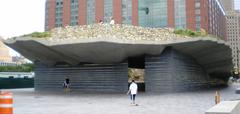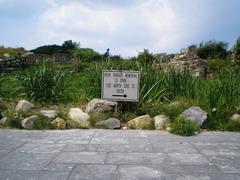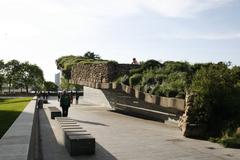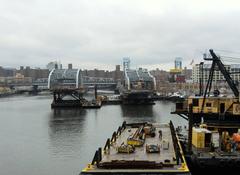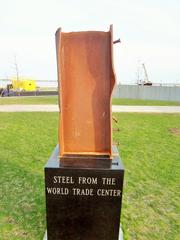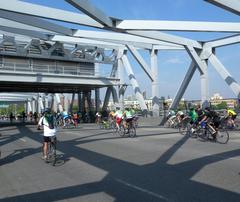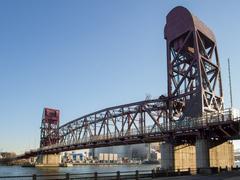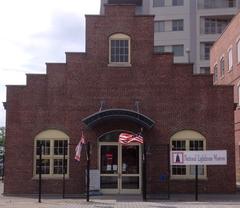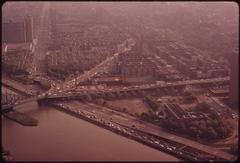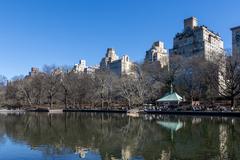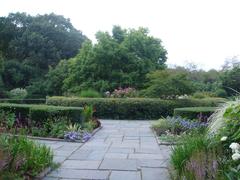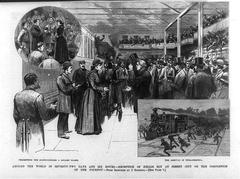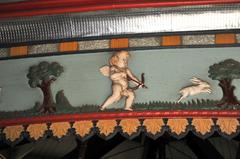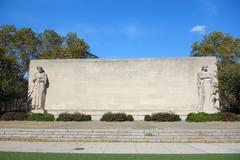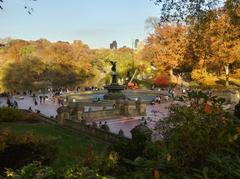
Irish Hunger Memorial Visiting Guide
Date: 24/07/2024
Introduction
The Irish Hunger Memorial in New York City is a profound tribute to the Great Irish Famine of 1845-1852, an event that led to the death of approximately one million people and caused another million to emigrate, profoundly impacting Irish history and diaspora (NYC Arts). This memorial, situated in the heart of Battery Park City, serves not only as a remembrance of this tragic historical event but also as a poignant reminder of ongoing global hunger issues. Designed by artist Brian Tolle, landscape architect Gail Wittwer-Laird, and 1100 Architect, the memorial combines elements of historical significance with modern design to create an immersive and reflective visitor experience. This guide aims to provide a comprehensive overview of the Irish Hunger Memorial, including its history, design, and practical visitor information, ensuring that visitors can fully appreciate the depth and significance of this important landmark.
Table of Contents
- Introduction
- Visiting the Irish Hunger Memorial
- Conclusion
- References
Visiting the Irish Hunger Memorial
History and Cultural Significance
The Irish Hunger Memorial in New York City is a poignant tribute to the Great Irish Famine of 1845-1852, also known as ‘An Gorta Mor’ or ‘The Great Hunger.’ Designed to raise awareness about historical and contemporary issues of hunger, the memorial is a collaborative creation by artist Brian Tolle, landscape architect Gail Wittwer-Laird, and 1100 Architect. Located on a half-acre site at the corner of Vesey Street and North End Avenue in Battery Park City, the memorial offers a reflective space for visitors with views of the Hudson River.
Design and Features
Architectural Team and Concept
The design of the Irish Hunger Memorial is rooted in both historical remembrance and contemporary relevance. The base of the structure is made from Kilkenny limestone, imported from Ireland, connecting the memorial to its Irish heritage.
Structural Elements
Elevated on a limestone plinth measuring 96 feet by 170 feet, the memorial’s base is composed of Kilkenny limestone, over 300 million years old and containing ancient fossils.
Textual Bands and Illuminated Panels
One of the memorial’s most striking features is the nearly two miles of text wrapping around its base. Displayed in illuminated bands, these texts include quotations from various sources such as autobiographies, letters, and poems. At night, the backlit panels serve as a beacon, visible from the Hudson River.
The Cottage and Pathway
Central to the memorial is a ruined fieldstone cottage from Carradoogan, County Mayo, Ireland. Visitors enter through a ceremonial entrance resembling Irish Neolithic graves, leading to a ramped passageway ending inside the cottage.
Landscape and Vegetation
The memorial’s landscape mimics a rugged Irish terrain with abandoned potato fields and native Irish plants. The cultivated area references the 1847 Irish Poor Law, which exacerbated famine suffering by denying relief to those with more than a quarter-acre of land.
Cantilevered Overlook
At the western end, 25 feet above the pavement, a cantilevered overlook provides panoramic views of the Hudson River, the Statue of Liberty, and Ellis Island, symbolizing America’s welcome to immigrants.
Audio Installation
An audio installation enriches the visitor experience with contemporary writings and music, reflecting on the Great Irish Famine and current global hunger challenges.
Symbolic Features
Stones from each of Ireland’s 32 counties are incorporated into the memorial, symbolizing Irish unity. The pathway through the memorial leads visitors past the cottage and stone walls to a pilgrim’s standing stone, evoking a journey of reflection.
Visitor Information
Tickets and Visiting Hours
The Irish Hunger Memorial is open to the public year-round and does not require an entrance fee. Visiting hours are typically from dawn to dusk, but it’s advisable to check the official website for any updates or seasonal changes.
Accessibility
The memorial is accessible to visitors with disabilities. Ramped pathways ensure ease of movement for all visitors.
Nearby Attractions
Located in Battery Park City, the memorial is close to other attractions such as the Statue of Liberty, Ellis Island, and the 9/11 Memorial. A visit to the Irish Hunger Memorial can be part of a broader exploration of New York City’s historical sites.
Travel Tips
Visitors are encouraged to wear comfortable walking shoes and consider the weather, as much of the memorial is outdoors. Bringing a camera is recommended for capturing the stunning views from the cantilevered overlook.
Conclusion
The Irish Hunger Memorial is a significant landmark in New York City, blending historical elements with modern design to create a space for reflection and education. Whether you’re interested in history, architecture, or social issues, a visit to the memorial offers a deeply moving experience.
For more information and updates, visit the official website or follow on social media. Consider downloading the mobile app Audiala for more interactive experiences and updates on related sites.
